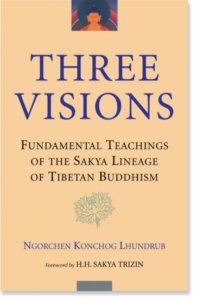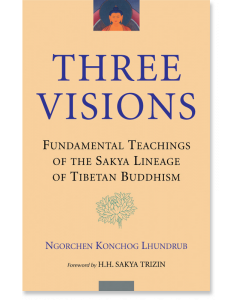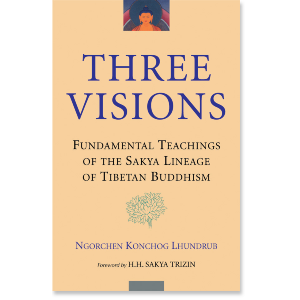| The following article is from the Spring, 2002 issue of the Snow Lion Newsletter and is for historical reference only. You can see this in context of the original newsletter here. |
Fundamental Teachings of the Sakya Lineage of Tibetan Buddhism

by Ngorchen Konchog Lhundrub, fore, by H.H. Sakya Trizin, trans, by Lobsang Dagpa and Jay Goldberg.
The most profound and fundamental teaching of the Sakya tradition of Tibetan Buddhism is that of the Path Including Its Result. This unique teaching of Virupa, one of India's extraordinary Mahasiddhas, covers the entire Buddhist path from the time of entering the spiritual discipline up to the attainment of full and perfect enlightenment. Though it comprehensively explains the tenets of the Buddha, its main function is to serve as a manual for contemplating and meditating upon the various stages leading to the final result of ultimate happiness and liberation.
The Three Visions examines the state of those experiencing suffering, those engaged in the methods leading towards freedom from unhap- piness and misery, and those fully enlightened ones who have attained the highest goal of omniscient awakening. In a very direct and simple manner, the text leads the reader step by step over the vast path culminating in ultimate peace.
77w Three Visions is important to more than just the Sakya tradition, as the teachings within are relevant to Buddhists of all traditions and lineages. A comprehensive synthesis of the views and practices of the Bodhisattva path, it is a definitive handbook that guides a practitioner on the path in a manner that is systematic, succinct and easy to understand. Sakya Jetsun Chimey Lading
I am delighted to see this republished translation of The Three Visions] an important teaching of benefit to all sentient beings.His Holiness Jigdal Dagchen Sakya
The higher levels of spiritual development depend upon transforming one's level of perception of reality. When in time the deeper realities present themselves as perceptions or visions, spiritual growth is experienced and is as subjective, personal, and flexible as the perceptions themselves, not as insurmountable as once thought.Lama Pema Wangdak, Palden Sakya New Jersey
[The Three Visions was originally published as The Beautiful Ornament of the Three Visions.]
The following is an excerpt from the Vision of Experience section of The Three Visions.
Arouse the body and mind into alertness and meditate. If unruliness arises, prevent it by relying upon the methods opposite to those (used to prevent sluggishness). When sluggishness and unruliness are pacified, relax (the mind) and meditate.
The five experiences of meditation: By meditating in this way, a continuous stream of thoughts will arise, one after another, which cannot be measured by the gross mind. Actually these thoughts were previously there, but since one never placed the mind in meditation they were never noticed. Now having become aware of them, there will arise such ideas as, my thoughts have become more than before, or I have failed to produce meditation. However, this is the first experience (of meditation), the experience of recognizing thoughts, which is known as like a steep mountain waterfall.
Through meditating in such a way, one will see one thought following after another. After a while, one's thoughts will cease, but immediately one will see the flow of thoughts arising again. In this way, one's thoughts will flow (and cease) alternately. This is the second experience (of meditation), the experience of the resting of thoughts, which is known as like the water in a deep, narrow gorge.
Again, through meditating with great diligence upon continually placing (the mind), at some point the flow of thoughts will reverse, like at the time of sneezing, and thoughts will cease. Through meditating upon this (ceasing) with greater sharpness, one's clarity of consciousness is occasionally interrupted by a sudden stream of thoughts. This third experience is the experience of tired thoughts, which is known as like the pool of three converging streams.
Again, through meditating in this continuous manner, most of the flow of thoughts will be allayed, and the mind will remain by resting in the state of one-pointed concentration. In that state, only one or two consecutive thoughts will arise, but then instantly they will die down again. This fourth experience is the experience of waves, which is known as like an ocean with waves.
Again, through meditating upon the continuity of that previous meditation itself, all outward and inward projection of thoughts completely disappear. The abiding of the one- pointedness of mind along with mind's clarity has arisen. This fifth experience is the experience of pacification of thoughts, which is known as like an ocean devoid of waves. Even though at this time the mind remains in clear one-pointed concentration, free from the activity of thoughts, if one fails to gain the sparkling clarity of consciousness, then it is the calm abiding of the unclear elements of mind.
Therefore, to keep the mind in one-pointedness, one should meditate until the sparkling clarity of consciousness arises, which is like the flame of a lamp unagitated by air. By meditating in this way, if the clear aspect of the object arises, then without looking at the object of one's meditation, one should place one's mind on the clear aspect of one's own consciousness itself by turning the mind inward. If sluggishness and unruliness arise, dispel them by the (above) methods. Without any effort and at ease, remain within the state of the sparkling clarity of mind. By meditating in this refined way, if one's meditation is not good in the beginning of the session but improves toward theerrd of session, then one needs diligence; therefore one should meditate upon one-pointedness diligently. After applying diligence, if one's mind projects outward, does not like to remain in one-pointed concentration, and one becomes mentally and physically uncomfortable, this arises because of the application of too much diligence. So, one should meditate in a relaxed state. One should eat moderately and eat whatever is suitable for one's health. One should restore one's health by sleeping properly, not reversing day and night for sleep. When one has restored one's health, then meditate diligently.

To keep the mind in one-pointedness, one should meditate until the sparkling clarity of consciousness arises, which is like the flame of a lamp unagitated by air.
To contemplate on the meaning of this, one should reside in an isolated place, seated upon a comfortable cushion in Lord Valrocana's posture, and precede the session by reciting the refuge, the complimentary prayer, and the creation of the enlightenment thought. Then one should think, Alas! From beginningless Samsara until now, my mind has been blown around by the wind of conceptualization, and has been doing whatever it desired. It has not been able to abide even the time of the snap of the fingers in one-pointed concentration on a virtuous object. Therefore I have still not crossed the ocean of worldly existence and have not obtained the power to liberate others. This is not good. So now, having relied upon the instruction of a spiritual friend, I must accomplish the special joy of complete purification of body and mind. Having placed my mind in the absorption of one- pointedness, 1 must obtain the great enlightenment.



